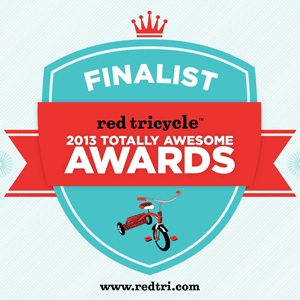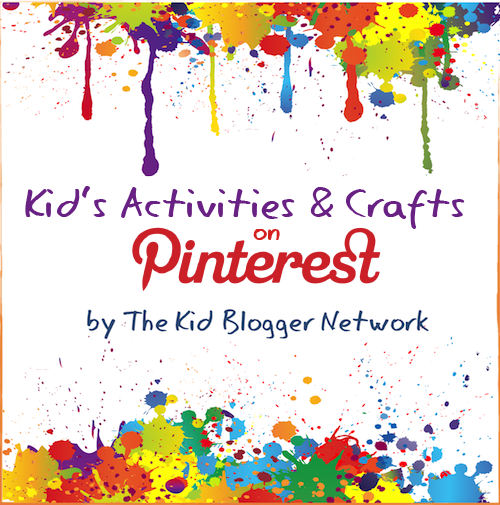Nurturing kids' creativity and thinking skills is an important role for parents. The toys we give our kids to play with can either help or hinder their creative thinking.
Two important points to keep in mind when choosing toys for your kids:
1. A general rule of thumb for us is that if it requires batteries, it probably isn't going to be a creative toy (that's not always the case, but usually).
2. 'Toys' needn't include only store-bought items. There are lots of things that kids can play with that will help them develop their creative thinking skills.
***
Cardboard boxes - Large and small, cardboard boxes make for wonderfully creative play tools! Make a Cardboard Box Puppet Theatre, or if you're not the artsy-craftsy type, all you really need is a cardboard box with a hole cut in the back, as pictured above. Try making a cardboard box aquarium, a shop, or even a cardboard city - perfect for imaginary play and small world play scenes.
For more creative cardboard box ideas, see:
Train Tunnel by Thrive 360 Living
Bird's Nest by Wildlife Fun 4 Kids
60 more box ideas at 123 Homeschool 4 Me
***
Expired rice or barley - They're super for sensory play; add some little figures for imaginary/small world play or cups and scoops for pouring. They're easy to dye if you want to make them colourful, but they're good plain, too. Try other kitchen staples such as lentils or dried beans.
***
Sewing kit - You can get kids' plastic sewing needles at hobby or toy shops. Pair them with some craft foam or felt for creative fine motor skills practice. Kids can sew lines, shapes, or draw their own picture to 'embroider'. After they have explored the materials, you might want to introduce some simple kids' sewing projects (from Teach Beside Me).
***
Paper dolls - Store bought or make your own. Kids love to make them to look like themselves. Even with the store bought kind, let them make their own clothes for them out of scraps of colourful paper or fabric (these fabric ones from Julia's Book Bag are beautiful!) This was my own personal favourite toy when I was a kid and it's still a winner! You could also make some simple stands for them, like Happy Hooligans did, so they can stand up during imaginary play.
***
***
Dress-up costumes and accessories - All kids love to dress up and pretend to be something or someone else! And it's a great way for them to try on the roles of all different people. Make your own costumes, buy ready-made costumes, put together bits and pieces of old clothes and accessories, and add some props if you like - here's a lovely example from Here Come The Girls of how props added to a costume make for extended imaginary play.
***
Blocks - Building with blocks of any kind, from lego to foam to wooden blocks, even empty tissue boxes, helps children build their creative thinking and problem-solving skills. Again, go with their interests - if your child loves robots, get some robot-themed lego; if your child loves flowers and princesses, get some colourful, wooden, fairytale castle blocks; you get the idea. You can read more all about the benefits of blocks over at Picklebums, and get some superb ideas of how to extend blocks play from An Everyday Story. Why not try making some homemade natural wood blocks like these ones by Stir the Wonder to add to their block collection and stimulate their imaginations?
***
***
Felt - Felt is a versatile material for a variety of creative play ideas. Make a threading game (either an elaborate one like this Very Hungry Caterpillar threading game if you're crafty, or a simple one with just squares of felt with slits cut in them), make a felt play board (or buy one already made) for kids to make play scenes, use it for crafts (it's easy for little hands to cut), for play food like this super simple pie set from The Pleasantest Thing, or for sewing practice.
***
Water - You really can't beat water play for lifting spirits on a cranky day, and it's a source of endless ways to play creatively. From bath time to the kitchen sink to outdoor play time, kids never tire of water play. Give them a tub to bathe their dolls, wash coins, clean their animal figures, make bubbles, pour and measure, paint the driveway, make hand/footprint art, wash your car, engage in small world/imaginary play ... your kids can find a hundred different, creative ways to play with water.
***
Sand - Like water, a sandbox provides a plethora of ways to play. A sandbox doesn't need to be big - if you only have a small outdoor space, even a balcony, you can make a mini sandbox in a plastic container or large plant pot.
***
Bottle caps - Another super versatile plaything! Stack them, use them as counters, label them with letters or numbers for word games or math games, or use them for craft projects.
***
Doll house - Endless hours are spent at the dollhouse in the Pea household, and it's where every visiting child (boy or girl) makes a beeline for whenever they come over. Refurbish a pre-loved dollhouse as we did, buy a new one, or make one out of boxes like Red Ted Art or even an old dresser.
***
Window crayons - For a change from drawing on paper, try window crayons. We find our kids' imaginations are sparked by the large, vertical 'canvas' before them. Kids of all ages can enjoy them - draw seasonal scenes, write messages, or just explore the feel of the soft crayons on the glass.
***
Sensory tubs - Sensory tubs are great for little ones to explore and discover how the world works. And you can make them out of just about anything! They don't need to be fancy or themed. Just a simple box with even just one type of object in it, such as rice or cotton wool, will do the job.
***
Magnifying glass - Open up your children's minds and help them to develop keen observational skills by exploring the world around them with a magnifying glass. Better yet, send them outdoors to observe nature up close and wonder at the marvels before them!
***
Chalk - Indoors or outdoors, chalk is a definite favourite at our house. Drawing pictures on a chalkboard, sidewalk, or even trees like Dilly Dali Art's kids did, painting with wet chalk, exploring different ways to make marks, drawing out a hopscotch board - chalk is a standard gift here whenever there's a stocking to be stuffed or an Easter basket to be filled or a birthday loot bag to go home. Trying making some sidewalk chalk paint or even fizzy sidewalk paint like on Kids' Activities Blog, or draw a life-sized board game with chalk, like this one from True Aim Education.
***

Play dough - A classic, with endless possibilities for creating! Play dough is also great for developing fine motor skills and hand strength, important for early writing development. Try our classic play dough recipe, a sparkly fragrant version, or this salt-free oatmeal play dough for sensitive skin.
***
Craft foam - Great for crafts, cutting and sewing practice (easy for small hands to cut with scissors or poke through with a needle), and - our personal favourite use for it - window clings! Buy pre-cut foam shapes or cut your own.
***
Mirrors - A versatile 'toy' suitable for all ages! Put a mirror in front of your baby to see and learn about himself, a toddler to practice making different expressions, a preschooler to watch how her body moves as she dances and jumps, or an older kid to study their features and draw a self-portrait.
***
Paper and pencils/crayons/markers - I can't even tell you how many hours a week our two little ones spend simply drawing.
***












































